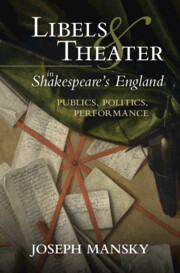Book contents
- Libels and Theater in Shakespeare’s England
- Libels and Theater in Shakespeare’s England
- Copyright page
- Dedication
- Contents
- Acknowledgments
- Abbreviations
- Introduction Seeds of Sedition
- Part I The Scene of Libel
- Chapter 1 How to Read a Libel in Early Modern England
- Chapter 2 Playing Libel from Cambridge to Kendal
- Part II Libels on the Elizabethan Stage
- Epilogue Staging Libel in Early Stuart England
- Bibliography
- Index
Chapter 2 - Playing Libel from Cambridge to Kendal
from Part I - The Scene of Libel
Published online by Cambridge University Press: 05 October 2023
- Libels and Theater in Shakespeare’s England
- Libels and Theater in Shakespeare’s England
- Copyright page
- Dedication
- Contents
- Acknowledgments
- Abbreviations
- Introduction Seeds of Sedition
- Part I The Scene of Libel
- Chapter 1 How to Read a Libel in Early Modern England
- Chapter 2 Playing Libel from Cambridge to Kendal
- Part II Libels on the Elizabethan Stage
- Epilogue Staging Libel in Early Stuart England
- Bibliography
- Index
Summary
This chapter explores the dramatic performance of libel. Aggrieved amateur playmakers across England made canny use of costume, props, meter, and other theatrical technologies to disseminate libels. Drawing from the Star Chamber records, the first section surveys the varieties of media and performance genres employed by libelers, including festive games, pageants, songs, and shows; street theater; and professional playing. Examples such as the Wells Shows of 1607, “The Death of the Lord of Kyme” in 1601, and even Shakespeare’s Merry Wives of Windsor illustrate the thorough hybridity of libelous performance. The rest of the chapter is devoted to two major case studies: the Kendal Stage Play of 1621 and the university play Club Law (1599–1600). These are prime examples of activist theater: they aimed not just to entertain their audiences but also to mobilize them, defame them, or otherwise incite them to action. Situated in their respective local contexts – the struggle over tenant right in Kendal and town–gown conflict in Cambridge – the surviving traces of these plays document the circulation of communal feelings that made libelous performance such a potent medium for bad publicity.
Keywords
- Type
- Chapter
- Information
- Libels and Theater in Shakespeare's EnglandPublics, Politics, Performance, pp. 58 - 84Publisher: Cambridge University PressPrint publication year: 2023



